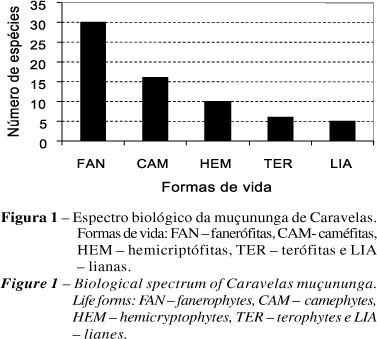Little is known about muçununga vegetation, which occurs surrounded by Tropical Rain Forests in northern Espirito Santo State and southern Bahia State, in sites with sandy and wet soils. This work had the objective of studying floristic and phytophysiognomic aspects in order to evaluate how human activity influenced the structure and composition of the muçununga vegetation of Caravelas (17o41'13''S and 39o28'24''W) and Mucuri (18o10'29''S and 39o53'25''W). This work was carried out trough paths in muçununga vegetation where botanical material was collected to produce a biological spectrum. At muçununga of Caravelas 67 species of 32 botanical families were found, and at Mucuri´s muçununga, 53 species of 31 families. From the floristic lists it was obvious that the muçununga of Caravelas was richer than that of Mucuri. In the profiles it is possible to see more evenness among species at muçununga of Caravelas than at Mucuri´s one. Human interferences benefit hemicryptophytes and lianas forms in Mucuri´s muçununga. Baccharis trimera, Blechnum serrulatum, Imperata brasiliensis and Pteridium aquilinum are indicative species for fire occurrence and cattle grazing. Human interferences were chiefly responsible for biodiversity reduction at muçununga vegetation.
Savanna-like vegetation; restinga-like vegetation; phytosociology; flooded vegetation; profiles












